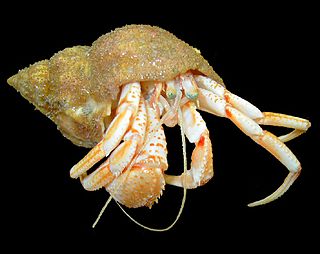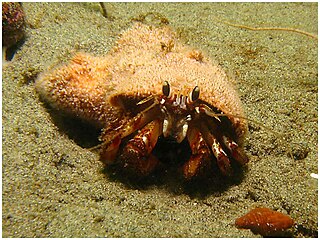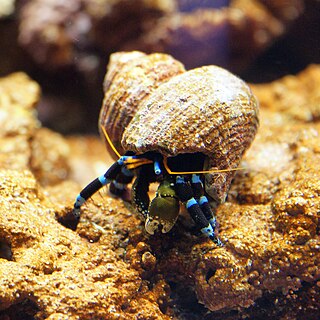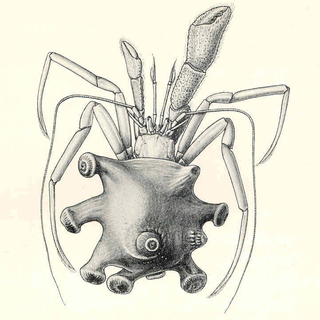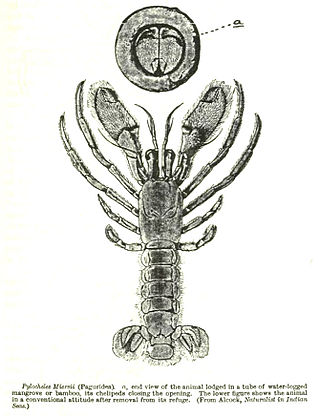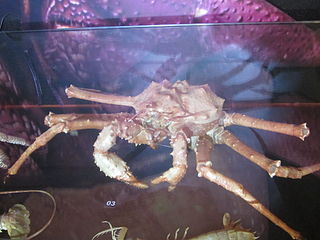| Paguridae | |
|---|---|
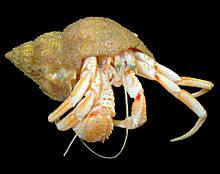 | |
| Pagurus bernhardus | |
| Scientific classification | |
| Domain: | Eukaryota |
| Kingdom: | Animalia |
| Phylum: | Arthropoda |
| Class: | Malacostraca |
| Order: | Decapoda |
| Suborder: | Pleocyemata |
| Infraorder: | Anomura |
| Superfamily: | Paguroidea |
| Family: | Paguridae Latreille, 1802 |
The Paguridae are a family of hermit crabs of the order Decapoda. The king crabs, Lithodoidea, are now widely understood to be derived from deep within the Paguridae, with some authors placing their ancestors within the genus Pagurus. [1]
This family contains 542 species in over 70 genera: [2] [3]
- Acanthopagurus de Saint Laurent, 1968
- Agaricochirus McLaughlin, 1981
- Alainopaguroides McLaughlin, 1997
- Alainopagurus Lemaitre & McLaughlin, 1995
- Alloeopagurodes Komai, 1998
- Anapagrides de Saint Laurent-Dechance, 1966
- Anapagurus Henderson, 1886
- Anisopagurus McLaughlin, 1981
- Bathiopagurus McLaughlin, 2003
- Bathypaguropsis McLaughlin, 1994
- Benthopagurus Wass, 1963
- Boninpagurus Asakura & Tachikawa, 2004
- Bythiopagurus McLaughlin, 2003
- Catapaguroides A. Milne-Edwards & Bouvier, 1892
- Catapaguropsis Lemaitre & McLaughlin, 2006
- Catapagurus A. Milne-Edwards, 1880
- Ceratopagurus Yokoya, 1933
- Cestopagurus Bouvier, 1897
- Chanopagurus Lemaitre, 2003
- Cycetopagurus McLaughlin, 2004
- Decaphyllus de Saint Laurent, 1968
- Dentalopagurus McLaughlin, 2007
- Diacanthurus McLaughlin & Forest, 1997
- Discorsopagurus McLaughlin, 1974
- Elassochirus Benedict, 1892
- Enallopaguropsis McLaughlin, 1981
- Enallopagurus McLaughlin, 1981
- Enneobranchus Garcia-Gomez, 1988
- Enneopagurus McLaughlin, 1997
- Enneophyllus McLaughlin, 1997
- Forestopagurus Garcia-Gomez, 1995
- Goreopagurus McLaughlin, 1988
- Hachijopagurus Osawa & Okuno, 2003
- Haigiopagurus McLaughlin, 2005
- Icelopagurus McLaughlin, 1997
- Iridopagurus de Saint Laurent-Dechance, 1966
- Labidochirus Benedict, 1892
- Lithopagurus Provenzano, 1968
- Lophopagurus McLaughlin, 1981
- Manucomplanus McLaughlin, 1981
- Michelopagurus McLaughlin, 1997
- Micropagurus McLaughlin, 1986
- Munidopagurus A. Milne-Edwards, 1880
- Nematopaguroides Forest & de Saint Laurent, 1968
- Nematopagurus Milne-Edwards & Bouvier, 1892
- Orthopagurus Stevens, 1927
- Ostraconotus A. Milne-Edwards, 1880
- Paguridium Forest, 1961
- Paguritta Melin, 1939
- Pagurixus Melin, 1939
- Pagurodes Henderson, 1888
- Pagurodofleinia Asakura, 2005
- Pagurojacquesia de Saint Laurent & McLaughlin, 2000
- Pagurus Fabricius, 1775
- Parapagurodes McLaughlin & Haig, 1973
- Phimochirus McLaughlin, 1981
- Porcellanopagurus Filhol, 1985
- Propagurus McLaughlin & de Saint Laurent, 1998
- Protoniopagurus Lemaitre & McLaughlin, 1996
- Pseudopagurodes McLaughlin, 1997
- Pteropagurus McLaughlin & Rahayu, 2006
- Pumilopagurus McLaughlin & Rahayu, 2008
- Pygmaeopagurus McLaughlin, 1986
- Pylopaguridium McLaughlin & Lemaitre, 2001
- Pylopaguropsis Alcock, 1905
- Pylopagurus A. Milne-Edwards & Bouvier, 1891
- Rhodochirus McLaughlin, 1981
- Scopaeopagurus McLaughlin & Hogarth, 1998
- Solenopagurus de Saint Laurent, 1968
- Solitariopagurus Türkay, 1986
- Spathapagurus Lemaitre & Felder, 2011 [4]
- Spiropagurus Stimpson, 1858
- Tarrasopagurus McLaughlin, 1997
- Tomopaguroides Balss, 1912
- Tomopaguropsis Alcock, 1905
- Tomopagurus A. Milne-Edwards & Bouvier, 1893
- Trichopagurus de Saint Laurent, 1968
- Turleania McLaughlin, 1997
- Xylopagurus A. Milne-Edwards, 1880



